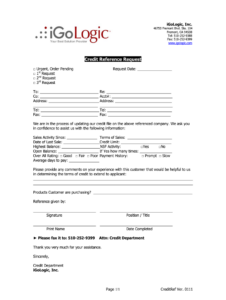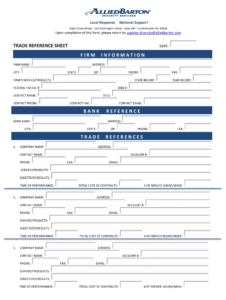Utilizing such a structured approach offers significant advantages. It reduces the time and effort required to collect necessary data, enabling faster credit decisions. Furthermore, the structured format ensures comprehensive data collection, minimizing the risk of overlooking critical information. This, in turn, leads to more informed credit assessments and minimizes potential financial losses. Additionally, a professional, well-crafted document enhances the requesting company’s image, fostering stronger relationships with potential creditors.
This article explores the key components of these valuable forms, offering practical guidance on their creation and effective utilization. It delves into best practices for requesting information, as well as strategies for interpreting responses to make sound credit decisions.
Key Components of a Credit Reference Request
Effective credit evaluations rely on comprehensive information. A well-structured reference request form ensures consistent data collection, facilitating informed decision-making. The following components are essential:
1. Requesting Company Information: Clear identification of the requesting business, including name, address, and contact information, establishes legitimacy and professionalism.
2. Applicant Company Information: Accurate identification of the business being evaluated, including legal name, address, and contact details, is crucial for proper identification and verification.
3. Credit Information Request: Specific questions regarding the applicant’s credit history, including payment terms, credit limits, and any outstanding balances, form the core of the request.
4. Payment History Inquiry: Detailed inquiries about the applicant’s payment promptness, frequency of late payments, and any history of defaults provide valuable insights into their financial responsibility.
5. Relationship Details: Understanding the nature and duration of the business relationship between the reference and the applicant offers context for evaluating the provided information.
6. Overall Satisfaction Inquiry: A general assessment of the reference’s satisfaction with the applicant’s overall financial performance adds a qualitative dimension to the evaluation.
7. Confidentiality Statement: Including a statement ensuring the confidentiality of the provided information encourages open and honest feedback.
8. Authorization and Signature: Space for the reference to authorize the release of information and provide a signature validates the response and adds a layer of formality.
These elements ensure the collection of pertinent data, enabling thorough credit assessments and mitigating potential risks.
How to Create a Business Credit Reference Request
Developing a standardized request form is crucial for efficient and consistent credit evaluations. A well-crafted document ensures the collection of pertinent information, enabling informed decision-making.
1. Define Objectives: Clearly outline the specific information required to assess creditworthiness. This ensures the request remains focused and relevant.
2. Structure the Form: Organize the form logically, grouping related information together. Clear headings and concise instructions enhance readability and ease of completion.
3. Request Essential Information: Include fields for the applicant’s legal name, address, contact details, and relevant identification numbers. This ensures accurate identification and verification.
4. Incorporate Key Questions: Formulate specific questions regarding payment history, credit limits, outstanding balances, and overall financial performance. Open-ended questions can provide valuable qualitative insights.
5. Maintain Professionalism: Use clear, concise language and a professional tone throughout the document. Avoid jargon and technical terms that may confuse the recipient.
6. Ensure Confidentiality: Include a statement assuring the confidentiality of the provided information. This encourages open and honest feedback from references.
7. Include Authorization: Provide space for the reference to authorize the release of information and sign the document. This adds a layer of formality and validates the response.
8. Review and Refine: Before implementation, thoroughly review the form for clarity, completeness, and accuracy. Pilot testing can identify areas for improvement and ensure effectiveness.
A systematic approach to development, incorporating these key elements, results in a robust tool that facilitates thorough and consistent credit assessments. This ultimately contributes to sound financial decision-making and minimizes potential risks.
Standardized forms for gathering credit information play a vital role in mitigating financial risk. Thorough credit evaluations, facilitated by the consistent collection of key data points such as payment history, credit limits, and overall financial performance, enable informed decision-making. Well-structured documents streamline the process, ensuring efficiency and minimizing the potential for overlooking critical information. Key components, including clear identification of parties involved, specific inquiries regarding credit history, and confidentiality assurances, contribute to a comprehensive and reliable assessment process.
Implementing robust credit evaluation processes contributes significantly to sound financial management. Developing and utilizing standardized credit reference request forms represents a proactive approach to risk mitigation, fostering stronger financial relationships and supporting sustainable business growth. Careful consideration of the elements outlined herein empowers organizations to make informed decisions, protecting their financial interests and fostering long-term stability. This proactive approach to credit management ultimately contributes to a more secure and prosperous business landscape.



